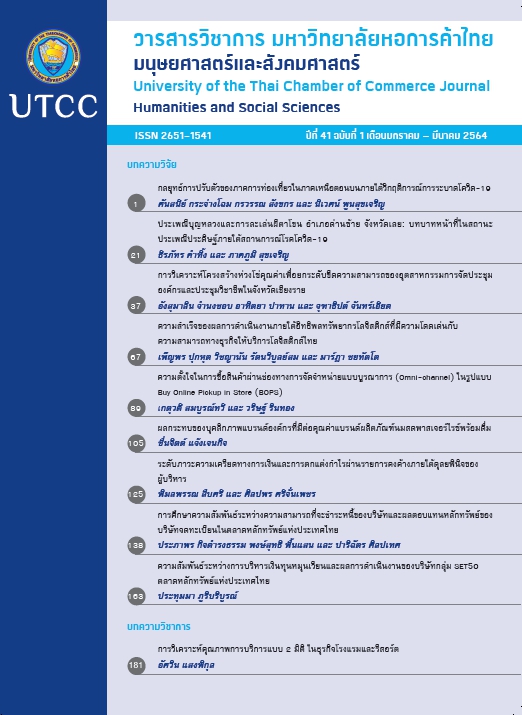Purchase Intention Towards Omni-Channel Retail: Buy Online Pickup in Store
Main Article Content
Abstract
The purpose of this research is to study purchase intention towards omni-channel
retailing in terms of attitudes and switching channels behavior. There are 417 samples
chosen by purposive sampling. The data were gathered by online questionnaire. This research
uses multiple regression to analyze and test hypothesis. The result showed that there are four
factors affecting omni-channel purchase intention at α = 0.05 which are information search,
attitude toward switching channels behavior, time, and self-efficacy whereas the factors of
subjective norm and money are not significant effect to omni-channel purchase intention at
α = 0.05.These findings suggest that retailing implementing omni-channel strategies should
utilize the data for designing distribution channel effectively, as well as improving its distribution
strategies to suit customers’ needs and these results may help retailing to implement
omni-channel as effective distribution strategies for making competitive advantages.
Article Details

This work is licensed under a Creative Commons Attribution-NonCommercial-NoDerivatives 4.0 International License.
ลิขสิทธิ์ของบทความ
ผลงานที่ได้รับการตีพิมพ์ถือเป็นลิขสิทธิ์ของมหาวิทยาลัยหอการค้าไทย ห้ามมิให้นำเนื้อหา ทัศนะ หรือข้อคิดเห็นใด ๆ ของผลงานไปทำซ้ำ ดัดแปลง หรือเผยแพร่ ไม่ว่าทั้งหมดหรือบางส่วนโดยไม่ได้รับอนุญาตเป็นลายลักษณ์อักษรจากมหาวิทยาลัยหอการค้าไทยก่อน
References
ณัฐปภัสร์ ดาราพงษ์ . (2560). ปัจจัยที่ส่งผลต่อการยอมรับเทคโนโลยี Mobile Banking (วิทยานิพนธ์ปริญญามหาบัณฑิต ไม่ได้ตีพิมพ์). มหาวิทยาลัยธรรมศาสตร์, กรุงเทพฯ.
พลเอก สังฑคุณ. (2560). ปัจจัยที่ส่งผลกับความตั้งใจซื้อบ้านของกลุ่มคนที่มีครอบครัว (การค้นคว้าอิสระปริญญามหาบัณฑิต ไม่ได้ตีพิมพ์). มหาวิทยาลัยธรรมศาสตร์, กรุงเทพฯ.
เมษา วัฒนพิชัย. (2558). ความสัมพันธ์ระหว่างทัศนคติและความตั้งใจซื้อของผู้บริโภคต่อการสื่อสารและการตลาดของร้านค้าสินค้าแฟชั่นออนไลน์ที่ไม่มีหน้าร้าน (การค้นคว้าอิสระปริญญามหาบัณฑิต ไม่ได้ตีพิมพ์). จุฬาลงกรณ์มหาวิทยาลัย, กรุงเทพฯ.
วิภาวรรณ มโนปราโมทย์. (2556). ปัจจัยที่มีอิทธิพลต่อการตัดสินใจซื้อสินค้าผ่านสังคมออนไลน์ (อินสตา แกรม) ของประชากรในกรุงเทพมหานคร (การค้นคว้าอิสระปริญญา มหาบัณฑิต ไม่ได้ตีพิมพ์). มหาวิทยาลัยกรุงเทพ.
อรรัมภา หัวใจ, จิดาภา หิรัญวงศ์สว่าง, ศรุต ชินประพินพร, ธีราพร เมฆอาภรณ์, ธนวรรณ ธนพร วิริยะกุล, ตปนีย์ ทิพย์ผ่อง,… พิชญา รัศมีจันทร์ (2557). Omni-Channel Marketing. Marketing and Branding for Quality, 21(204), 66-68.
Ajzen, I. (1991). The theory of planned behavior. Organizational Behavior and Human Decision Processes, 50(2), 179-211.
Ames, B. (2015). Pursuing the promise of omnichannel retailing. Supply Chain Quarterly, 4, 20-23.
Bandura, A. (1997). Self-efficacy: The exercise of control (3rd ed.). New York, NY: Freeman.
Blackwell, R. D., Miniard, P. W., & Engel, J. F. (2001). Consumer behavior (8th ed.). Fort Worth, TX: Harcourt College.
Choi, I., & Park, K. (2006). Designing and implementing a case-based learning environment for enhancing ill-structured problem-solving classroom management problems for prospective teachers. Educational Technology Research & Development, 57(1), 99-129.
Cochran, G. W. (1963). Sampling techniques (3rd ed.). New York, NY: Wiley.
Dodds, W. B., Monroe, K., & Grewal, D. (1991). Effects of price, brand, and store information on buyers' product evaluations. Journal of Marketing Research, 28(3), 413-419.
Eunhye, K., Jongtae, L., & Myeong-Cheol, P. (2017). Determinants of the intention to use Buy-Online, Pickup In- Store (BOPS): The moderating effects of situational factors and product type. Telematics and Informatics, 34(8), 1721-1735.
Fishbein, M., & Ajzen, I. (1980). Belief, attitude, intention and behavior: An introduction to theory and research. Boston, MA: Addison-Wesley.
FMI and Nielsen release first set of findings on the digitally engaged food shopper. (2017).
Retrieved May 12, 2020, from https://www.nielsen.com/us/en/press-releases/2017/fmi-and-nielsen-release-first-set-of-findings-on-the-digitally-egage-food-shopper/
Hair, J. F., Black, W. C., Babin, B. J., & Anderson, R. E. (2010). Multivariate data analysis (6th ed.). Upper Saddle River, NJ: Pearson Education.
Hellier, P. K., Geursen, G. M., Carr, R. A., & Rickard, J. A. (2003). Customer repurchase intention: A general structural equation model. European Journal of Marketing, 37(11/12), 1762-1800.
Marmorstein, H., Grewal, D., Fishe, P. H. (1992). The value of time spent in price - comparison shopping: Survey and experimental evidence. Journal of Consumer Research, 19(1), 52-61.
Matzler, K., Bidmon, S., & Grabner-Kräuter, S. (2006). Individual determinants of brand affect: The role of the personality traits of extraversion and openness to experience. Journal of Product & Brand Management, 15(7), 427-494.
Menard, S. (2002). Applied logistic regression analysis (2nd ed.). New York, NY: Sage.
Murfield, M., Boone, C. A., Rutner, P., & Thomas, R. (2017). Investigating logistics service quality in omni-channel retailing. International Journal of Physical Distribution & Logistics Management, 47(4), 263-296.
Sanjukta, A. P. (2008). Explaining consumers’ channel-switching behavior using the theory of planned behavior (Unpublished doctoral dissertation). University of Missouri.
Shih, H. P. (2004). An empirical study on predicting user acceptance of e-shopping on the web. Information & Management, 41(3), 351-368.
Soyeon, S., Mary, A. E., & Sherry, L. (2001). An online pre-purchase intentions model: The role of intention to search. Journal of Retailing, 77(3), 397-416.
Stajkovic, A. D., & Luthans, F. (1998). Self-efficacy and work-related performance: A meta-analysis (Unpublished doctoral dissertation). University of California.Thailand trade and services sentiment index. (n.d.). Retrieved May 12, 2020, from
https://www.ceicdata.com/en/thailand/trade-and-services-sentiment-index/tssi-by sector-retail-store-modern-present
Verhoef, P. C., Kannan, P.K., & Inman, J. (2015). From multi-channel retailing to omni-channel retailing. Journal of Retailing, 14(3), 3-4.
Widyani, A. A. D., Sarmawa, I. W. G., & Dewi, I. G. A. M. (2017). The roles of knowledge sharing in nediating the effect of self-efficacy and self-leadership towards innovative behavior. Journal Manajemen Dan Kewirausahaan, 9(2), 112-117.
Zeithmal, V. A. (1988). Consumer perceptions of price, quality and value: A means-end model and synthesis of evidence. Journal of Marketing, 52(3), 2-22.


